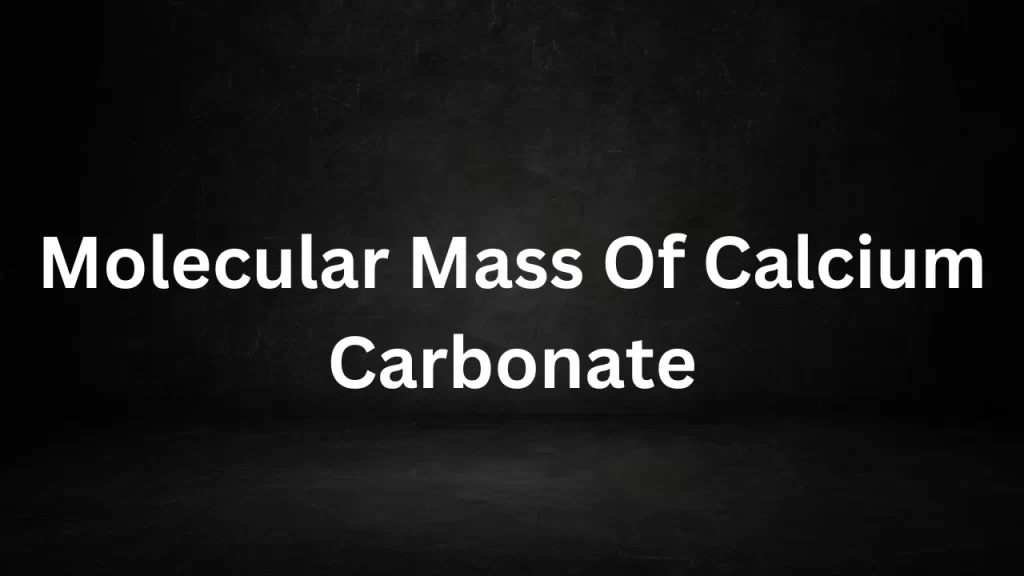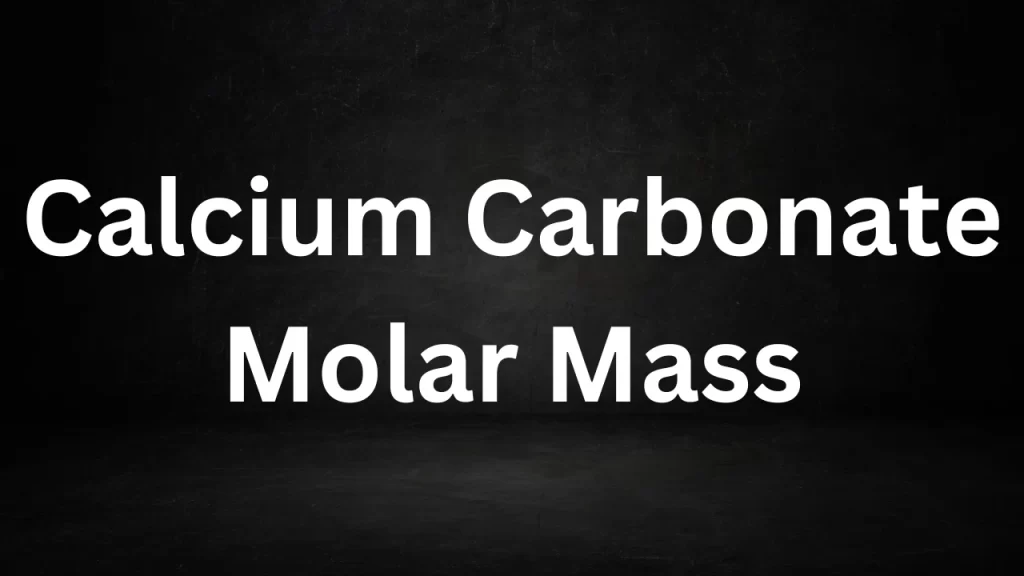Tag: calcium carbonate formula mass
Molecular Mass Of Calcium Carbonate
Molecular Mass Of Calcium Carbonate: The molecular mass of calcium carbonate, often referred to as calcium carbonate’s molar mass, is a fundamental concept in chemistry.
It plays a crucial role in various scientific fields, including chemistry, geology, environmental science, and industry. In this article, we will explore what the molecular mass of calcium carbonate is, how it is calculated, its significance, and its practical applications.

Molecular Mass Of Calcium Carbonate
Defining Molecular Mass
The molecular mass, also known as molar mass, of a compound is the mass of one mole of that substance expressed in grams per mole (g/mol). In the case of calcium carbonate (CaCO3), its molecular mass represents the combined mass of one mole of calcium (Ca) atoms, one mole of carbon (C) atoms, and three moles of oxygen (O) atoms.
Calculation of Molecular Mass
To calculate the mole mass of calcium carbonate (CaCO3), we sum the atomic masses of its constituent elements:
- Calcium (Ca): Atomic mass ≈ 40.08 g/mol
- Carbon (C): Atomic mass ≈ 12.01 g/mol
- Oxygen (O): Atomic mass ≈ 16.00 g/mol
Now, let’s calculate the mole mass of CaCO3:
Molecular Mass of CaCO3 = (Molar Mass of Ca) + (Molar Mass of C) + (3 × Molar Mass of O)
The Molecular Mass of CaCO3 = (40.08 g/mol) + (12.01 g/mol) + (3 × 16.00 g/mol)
Molecular Mass of CaCO3 ≈ 100.09 g/mol
Therefore, the mole mass of calcium carbonate (CaCO3) is approximately 100.09 grams per mole.
Significance in Chemistry
- Stoichiometry: The mole mass of calcium carbonate is fundamental in stoichiometry, allowing chemists to calculate the quantities of reactants and products in chemical reactions involving CaCO3.
- Formulation Chemistry: It is important in industries like agriculture and pharmaceuticals for formulating products that contain calcium carbonate.
- Environmental Science: Knowledge of the molecular mass of CaCO3 is essential for understanding its role in environmental processes, such as the dissolution of limestone in natural waters.
Real-World Applications
- Geology: The mole mass of calcium carbonate is crucial in geological studies, where it helps identify and quantify carbonate minerals in rocks and sediments.
- Agriculture: Calcium carbonate is commonly used as a soil conditioner and in the formulation of agricultural products, benefiting from its mole mass calculations.
- Pharmaceuticals: It finds applications in antacids and calcium supplements, where the molecular mass influences dosages and formulations.
- Environmental Monitoring: Understanding the mole mass is important for analyzing the presence and concentration of calcium carbonate in natural water bodies, which can affect water quality and aquatic life.
Conclusion
The mole mass of calcium carbonate (CaCO3), approximately 100.09 g/mol, is a foundational concept in chemistry with broad-reaching implications. It serves as a cornerstone in stoichiometry, formulating various industrial products, and understanding environmental processes. Additionally, its significance extends to geological studies, agriculture, pharmaceuticals, and environmental monitoring. An in-depth comprehension of the mole mass of calcium carbonate is not only essential for scientific research but also for addressing practical challenges in diverse fields.
Read More
- Molar Mass Of Carbon Dioxide
- Difference Between Force And Momentum
- Law Of Conservation Of Linear Momentum
- Molecular Weight Of MgSO4
- Molecular Weight Of H3PO4
Frequently Asked Questions (FAQs) On Molecular Mass Of Calcium Carbonate
1. What is the molecular mass of calcium carbonate (CaCO3)?
The mole mass of calcium carbonate (CaCO3) is approximately 100.09 grams per mole (g/mol).
2. How is the molecular mass of calcium carbonate calculated?
To calculate the molecular mass of CaCO3, you sum the atomic masses of its constituent elements: calcium (Ca), carbon (C), and oxygen (O).
3. What is the atomic mass of calcium (Ca)?
The atomic mass of calcium is approximately 40.08 g/mol.
4. What is the atomic mass of carbon (C)?
The atomic mass of carbon is approximately 12.01 g/mol.
5. What is the atomic mass of oxygen (O)?
The atomic mass of oxygen is approximately 16.00 g/mol.
Calcium Carbonate Molar Mass
Calcium Carbonate Molar Mass: Calcium carbonate is a chemical compound that plays a crucial role in various aspects of our lives, from its presence in natural formations like limestone and marble to its use in industries such as agriculture, construction, and medicine.
One fundamental concept in chemistry that helps us understand and work with calcium carbonate is its molar mass. In this article, we will explore what molar mass is, how it relates to calcium carbonate, and its significance in various applications.

Calcium Carbonate Molar Mass
What Is Molar Mass?
Molar mass, also known as molecular weight, is a fundamental concept in chemistry that refers to the mass of one mole of a substance. Within the realm of chemistry, a mole stands as a foundational unit for quantifying substances, symbolizing approximately 6.022 x 10^23 particles—widely recognized as Avogadro’s number. The molar mass of a substance, expressed in grams per mole (g/mol), aligns numerically with the atomic or molecular weight of that particular substance.
Calcium Carbonate Composition
Calcium carbonate is represented by the chemical formula CaCO3, signifying that each calcium carbonate molecule comprises one calcium (Ca) atom, one carbon (C) atom, and three oxygen (O) atoms. Calculating its molar mass entails adding the atomic masses of these elements.
Calcium (Ca) has an atomic mass of approximately 40.08 g/mol, carbon (C) has an atomic mass of about 12.01 g/mol, and oxygen (O) has an atomic mass of roughly 16.00 g/mol. To calculate the molar mass of calcium carbonate (CaCO3), we add these values together:
Mol Mass of CaCO3 = (1 x Atomic Mass of Ca) + (1 x Atomic Mass of C) + (3 x Atomic Mass of O)
Mol Mass of CaCO3 = (1 x 40.08 g/mol) + (1 x 12.01 g/mol) + (3 x 16.00 g/mol) ≈ 100.09 g/mol
So, the mol mass of calcium carbonate is approximately 100.09 g/mol.
Significance of Calcium Carbonate Molar Mass
- Stoichiometry: Molar mass is vital in stoichiometry, the study of quantitative relationships in chemical reactions, aiding in precise substance quantities in synthesis and analysis.
- Medication Formulation and Dosage: Calcium carbonate is a commonly used antacid for heartburn and indigestion relief. Its molar mass is crucial in medication formulation and dosing.
- Agriculture: In agriculture, calcium carbonate acts as a soil conditioner, neutralizing acidity, and supplying vital calcium to plants. Precise molar mass measurements are vital for determining correct application rates.
- Construction and Building Materials: Within the construction sector, calcium carbonate plays a pivotal role in producing cement, mortar, and diverse concrete formulations. The molar mass helps engineers and construction workers ensure the correct proportions in these materials for structural integrity.
- Environmental Impact: The mol mass of calcium carbonate is significant in evaluating its environmental impact, including calculating the carbon footprint of related industries.
Conclusion
Understanding the mol mass of calcium carbonate is essential for a wide range of applications in chemistry, medicine, agriculture, and industry. It allows us to make precise calculations, formulate medications, improve soil quality, and create durable building materials. Comprehending mol mass and its relevance to calcium carbonate enables experts to make informed contributions, benefiting various fields and society.
Read More
- Molar Mass Of Ammonia
- Molecular Mass Of Acetic Acid
- Molecular Weight Of Calcium Carbonate
- Molecular Weight Of Sodium Hydroxide
- Molecular Weight Of Aluminium
Frequently Asked Questions (FAQs) On Calcium Carbonate Molar Mass
1. What is molar mass, and why is it important in chemistry?
Molar mass, also known as molecular weight, signifies the mass of one mole of a substance, expressed in g/mol. This concept plays a vital role in chemistry by helping determine the quantities of substances involved in chemical reactions. This determination is essential for stoichiometry, a fundamental aspect of chemistry, and is applicable in various areas within the discipline.
2. How is the molar mass of calcium carbonate calculated?
To find the molar mass of CaCO3, sum the atomic masses of its constituent elements in the formula. For CaCO3, you sum the atomic masses of calcium (Ca), carbon (C), and oxygen (O). Calculate the CaCO3 molar mass by adding the atomic masses of Ca, C, and O, as follows.
3. What is the molar mass of calcium carbonate?
The mol mass of calcium carbonate (CaCO3) is approximately 100.09 grams per mole (g/mol).
4. Why is knowing the molar mass of calcium carbonate important in medicine?
Calcium carbonate is a frequently employed antacid for alleviating symptoms of heartburn and indigestion. Knowledge of its molar mass is essential in formulating medications and determining the appropriate dosages to ensure effective treatment.
5. How is calcium carbonate used in agriculture, and why is its molar mass significant in this context?
In agriculture, calcium carbonate serves as a soil conditioner, addressing acidic soil conditions while supplying essential calcium to plants. Its molar mass is important for calculating the correct application rates to improve soil quality and promote healthy plant growth.